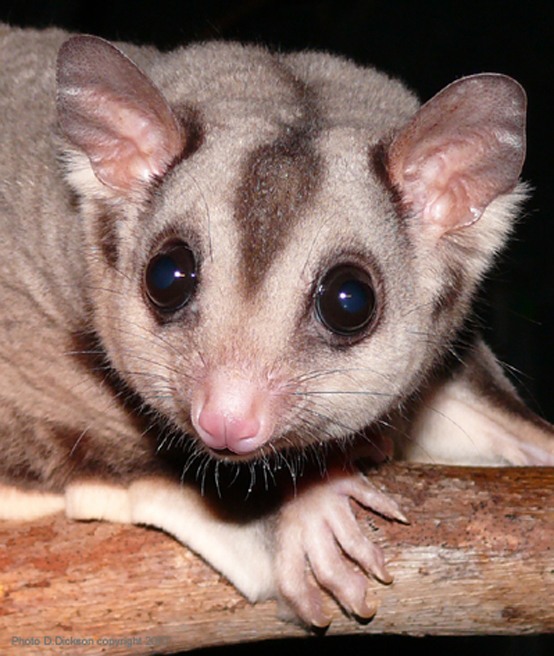| WILDWATCH by LAWRIE MARTIN. “We knew very little about the mahogany glider and finding one in a fallen tree on our club grounds brought home the reality of the plight facing this little Queenslander,” John Guyatt said. Mr Guyatt, involved in the Cardwell Reconstruction programme, was speaking at the Cardwell Country Club last week when a group of concerned citizens gathered to discuss the allocation of Federal Government funding under the Caring for Country programme to improve habitat for mahogany gliders (Petaurus gracilis). |
This revelation gave cause for a rethink at the Country Club, with a decision being made to highlight the fact the club is prepared to assist in the preservation of this rare glider and spread the word on the tourist trail to show Cardwell is a caring community.
Allied with mahogany glider presence on Country Club land is the discovery of glider presence on the nearby football ground. A mahogany glider was trapped and released on this ground during a post-cyclone survey last August, heartening news for those involved in trying to save the critically endangered mahogany glider.
This was brought out at last week’s meeting hosted by Terrain NRM where some 30 caring people, National Parks and Wildlife Service, Hinchinbrook Shire Council, Cassowary Coast Regional Council, WPSQ, DERM, Girringun and other environmental groups attended and all discussion was positive..
The meeting conclusively agreed to concentrate time, money and energy to do everything in its power to save the flagging population of mahogany gliders which, without sufficient useful habitat available to them, according to experts appeared destined for local extinction.
The first resolution was to construct a connecting corridor of glider food trees from the Country Club to the football ground.
Members of Tully’s WPSQ branch, and friends, have been campaigning for more than two decades to save this rare little nocturnal mammal, which is only found in a narrow strip of lowland country some 20 kms wide from just south of Tully to some 40kms south of Ingham. This is its entire world habitat, so every tree in it used by the gliders is precious.
One of the scientists involved in the post-Yasi study suggested a slogan which sums up the gliders’ situation beautifully – “Mahogany glider, every tree matters to me”.
Knowing the largest hindrance to the glider’s welfare has been a fragmentation of habitat due to over-enthusiastic clearing of woodland, even before Yasi, conservationists believe Cardwell Country Club’s willingness to play a major role in saving the animal will be of benefit to the glider and Cardwell.
WPSQ Tully branch president, Sue Smith, said Cardwell Country Club is to be applauded for taking on board the importance of woodland trees on the property and recognising the responsibility of preventing further extinction of flora and fauna is a universal one.
“We congratulate the club and its members for forward-thinking in recognising the future for these endangered animals rests in their hands, and we look towards other progressive organisations to pick up the baton on behalf of threatened species,” Ms Smith said.
“Our branch members, alongside people from DERM, National Parks and Girringun rangers took part in the extensive post Cyclone-Yasi mahogany glider survey and while there has been further habitat loss, the gliders trapped and released during the survey showed there was real hope for their survival, provided they gain a helping hand.”
They are not on display yet, but people visiting Cardwell Country Club will soon be able to enjoy interpretive signs designed by wildlife artist and mahogany glider expert Daryl Dickson, featuring the mahogany glider.
“Most of all is the exciting fact is out there in trees on the golf course fairways can be found one of Australia’s, and the world’s, rarest animals. Now that is really exciting,” Mr Guyatt said.


